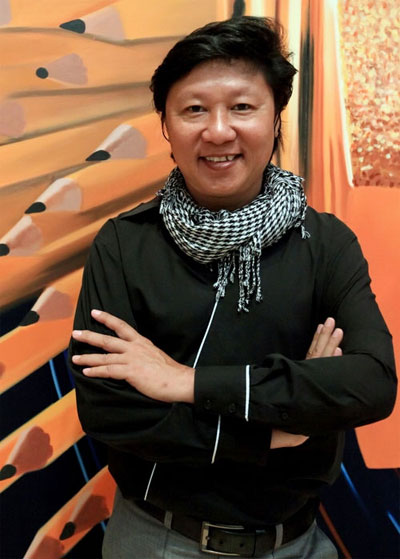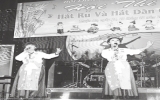Famous designer and the first ao dai museum in VN
 Ao dai designer Si Hoang.
Ao dai designer Si Hoang.
Along with a high entrance fee of VND100,00 – the most expensive museum in Viet Nam, your museum has been built within a large garden house which also features a stage, book store, souvenir shop and restaurant. What do you think about turning a museum into a business?
In Viet Nam, people often think of museums as sanctums dedicated to historical research and academic knowledge which are only able to survive through State support. It's a fair point which is also true in other countries. However, depending on a museum's strategy, more income can be made from additional services. In fact, many museums all over the world are following this trend.
As society develops, museums also need to adapt to people's requirements. I think this will create a stable income for the development of museums.
The high entrance fee seems to be putting domestic visitors off. Is your target mainly foreign tourists?
Compared with ticket prices at the Kimono Museum in Japan or the Hanbook Museum in South Korea, the price is very reasonable. Visitors can view hundreds of ao dai which relate to the country's history, and learn about the complicated process of creating a dress. They also can select an ao dai to try on and pose for a photo. I think those activities will lure visitors to the museum.
In addition, I can see that many foreigners show a great interest in traditional Vietnamese dress. By building this museum, I want to present the significant beauty of Vietnamese culture. That was one of my main purposes when I started the project more than 10 years ago.
Currently, the museum greets an average of 40 visitors each day. My target is to welcome 200 people. The museum only opened a few weeks ago and it's quite far from the city centre. The road leading to the museum is also incomplete, so I think the initial numbers are quite positive.
The ao dai museum is under the management of HCM City's Culture, Sports and Tourism Department. Have you received any support from authorities?
We received both policy and legal assistance from the municipal culture authority. I spent only nine months completing all the legal procedures – quite a short time for obtaining a permit to open a museum.
The media reported there are about 500 ao dai on display at the museum. However, the number is in fact much less. Can you tell us about this?
The objects on display have a specific theme, and that theme will be changed every three months. I currently own about 500 items, but I've only put a small part of my collection on display. They include a dress belonging to former diplomat Ton Nu Thi Ninh's family, and a "Le Mur" dress – the first-ever renovated ao dai created by painter Cat Tuong in the 1930s.
I can't showcase all my collection because some of them need to be stored very carefully in specially designed cases. After spending nearly US$5 million to build the museum, I now need a further VND10 billion ($470,000) to equip it, but that's beyond my current financial ability.
I also want to establish a library containing documents related to the history and development of the ao dai.
Alongside financial issues, do you face any other problems?
Finding suitable objects to put on display is another significant matter. Many valuable and beautiful ao dai are kept as heirlooms in many families, but it's hard for those families to share their treasures with the public.
However, some people understand my museum's purpose and have helped me to find new material. These include the son of painter Cat Tuong, who was also a famous ao dai tailor, and the daughter of Dung Da Kao – the first to create a renovated ao dai with raglan sleeves.
VNS
 Cultural tourism requires more investment to become cultural industry
Cultural tourism requires more investment to become cultural industry
 Thu Dau Mot city team wins high ranking prize at the second open Tai Tu Music Festival of Thu Duc city
Thu Dau Mot city team wins high ranking prize at the second open Tai Tu Music Festival of Thu Duc city
 Wrestlers dominate regional championships with 29 golds
Wrestlers dominate regional championships with 29 golds
 Special TV shows to mark 70th Liberation Day anniversary of Hanoi
Special TV shows to mark 70th Liberation Day anniversary of Hanoi
 Phase 2 of national troupe festival 2024 gathers vibrant cultural activities
Phase 2 of national troupe festival 2024 gathers vibrant cultural activities
 Nearly 200 union members and workers take part in sports festival of grassroots trade unions
Nearly 200 union members and workers take part in sports festival of grassroots trade unions
 Sports event celebrating the 25th anniversary of Binh Duong Young Entrepreneurs Association: Aiming for professionalism and methodical manner
Sports event celebrating the 25th anniversary of Binh Duong Young Entrepreneurs Association: Aiming for professionalism and methodical manner
 State-funded war film “Peach Blossom, Pho and Piano” to compete at Oscar
State-funded war film “Peach Blossom, Pho and Piano” to compete at Oscar
 Guam coach targets victory against Vietnam at AFC U20 Asian Cup qualifiers
Guam coach targets victory against Vietnam at AFC U20 Asian Cup qualifiers
 Binh Duong on-stage performing arts resilient contributions to tradition promotion
Binh Duong on-stage performing arts resilient contributions to tradition promotion



